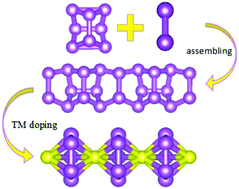A super stable assembled P nanowire with variant structural and magnetic/electronic properties via transition metal adsorption†
Abstract
By means of first-principles calculations, we systematically investigated the structure, stability and magnetic and electronic properties of one-dimensional P nanowire (1D-P10 NW) assembled by Pn subunits (n = 2, 8) and transition metal doped 1D-P10 NW. Our calculations showed that the assembled 1D-P10 NW is super stable in thermodynamic, dynamic, thermal and chemical perspectives. Moreover, when the assembled 1D-P10 NW is decorated with transition metals (TM = Ti ∼ Zn, Zr ∼ Mo), structural transformation occurs (to sandwich or quasi-sandwich chains), and various magnetic and electronic characteristics are introduced to the nanowire. Particularly, the sandwich chains 1D-Mn2@P10 and 1D-V1@P5 are a ferromagnetic semiconductor and a ferromagnetic half-metal, respectively, and the magnetic anisotropy energies are both ∼0.3 meV per Mn/V atom. Our theoretical studies proposed a super stable 1D P nanowire and also offer a feasible approach to reach ⋯P5–TM–P5–TM⋯ chains with diverse magnetic and electronic properties, as well as ferromagnetic vdW-type 2D systems, which are promising in nanoelectronic devices and spintronics.



 Please wait while we load your content...
Please wait while we load your content...